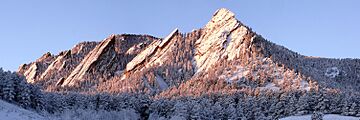Flatirons facts for kids
Quick facts for kids The Flatirons |
|
|---|---|

View of the first through fifth Flatirons from Chautauqua Park
|
|
| Highest point | |
| Geography | |
| Location | Boulder, CO |
The Flatirons are amazing rock formations in the western United States. You can find them close to Boulder, Colorado. These unique rocks look like giant, flat irons!
There are five main Flatirons, numbered from First to Fifth. They stand tall along the eastern side of Green Mountain. Green Mountain itself is about 8,148 feet (2,483 meters) high. Many other smaller Flatirons are also found on Green Mountain and Bear Peak.
Contents
What Are the Flatirons?
The Flatirons are huge, tilted slabs of rock. They are a famous landmark in Colorado. People often think of these five main rocks when they hear "The Flatirons."
Where Did the Name "Flatirons" Come From?
Long ago, around 1900, these rocks were called the "Chautauqua Slabs." A few years later, around 1906, they were known as "The Crags."
There are two main ideas about how they got their current name. One idea is that they look like the old-fashioned irons people used to press clothes. The other idea is that they resemble the famous Flatiron Building in New York City, which was finished in 1902.
How Did These Rocks Form?
The Flatirons are made of a type of rock called sandstone with small pebbles mixed in. Geologists, who study rocks, believe these rocks are incredibly old. They formed about 290 to 296 million years ago!
Later, between 80 and 35 million years ago, huge forces pushed and tilted these rocks. This event is called the Laramide Orogeny. Over millions of years, wind and water wore away the softer rock around them. This erosion exposed the hard Flatirons we see today.
You can see similar rock formations from the same time period in other parts of Colorado. These include Garden of the Gods near Colorado Springs and Red Rocks Amphitheatre near Morrison.
Fun Activities at the Flatirons
The Flatirons are part of the City of Boulder's Open Space and Mountain Parks system. They are a very popular spot for outdoor adventures.
Hiking and Climbing Adventures
Many people love to hike the trails around the Flatirons. For those who enjoy a challenge, rock climbing is also very popular here. The climbing routes range from easy for beginners to extremely difficult for expert climbers.
One famous climbing route is on the Third Flatiron. It's called the East Face Standard route. A well-known climber, Richard Rossiter, once said it was "The best 5.4 in the solar system." This means it's a fantastic climb for its difficulty level!
The Flatirons: A Symbol of Boulder
The numbered Flatirons on Green Mountain are a huge symbol of the city of Boulder. You can see pictures, drawings, paintings, and sculptures of them everywhere in the city.
Flatirons in Logos and Names
The city government, the University of Colorado, and many businesses use the Flatirons in their logos. They also appear in advertisements and marketing materials. Many businesses even use "Flatirons" or "Flatiron" in their names. Boulder is sometimes called "Silicon Flatirons" in the tech world, like how Silicon Valley is known for technology.
A University Tradition
For many years, from the 1950s until 1980, the Third Flatiron had a giant "CU" painted on it. These letters, about 50 feet tall, stood for the University of Colorado.
In November 1949, two CU students, Dale Johnson and Robert Rowlands, climbed the Flatiron at night to paint the first "C." Later, a "U" was added. In 1980, the city painted over the letters to help the rocks look more natural again. If you look closely, you can still faintly see the old letters under the reddish paint!
Images for kids
-
View of the first through fifth Flatirons from Chautauqua Park




